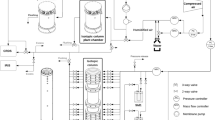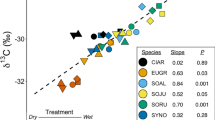Summary
Grassland communities of arid western North America are often characterized by a seasonal increase in ambient temperature and evaporative demand and a corresponding decline in soil moisture availability. As the environment changes, particular species could respond differently, which should be reflected in a number of physiological processes. Carbon isotope discrimination varies during photosynthetic activity as a function of both stomatal aperture and the biochemistry of the fixation process, and provides an integrated measure of plant response to seasonal changes in the environment. We measured the seasonal course of carbon isotope discrimination in 42 grassland species to evaluate changes in gas exchange processes in response to these varying environmental factors. The seasonal courses were then used to identify community-wide patterns associated with life form, with phenology and with differences between grasses and forbs. Significant differences were detected in the following comparisons: (1) Carbon isotope discrimination decreased throughout the growing season; (2) perennial species discriminated less than annual species; (3) grasses discriminated less than forbs; and (4) early flowering species discriminated more than the later flowering ones. These comparisons suggested that (1) species active only during the initial, less stressful months of the growing season used water less efficiently, and (2) that physiological responses increasing the ratio of carbon fixed to water lost were common in these grassland species, and were correlated with the increase in evaporative demand and the decrease in soil moisture.
Similar content being viewed by others
References
Arnow L, Albee B, Wyckoff A (1980) Flora of the Central Wasatch Front, Utah. Utah Museum Natural History, Salt Lake City
Brugnoli E, Hubick KT, von Caemmerer S, Farquhar GD (1988) Correlation between carbon isotope discrimination and leaf starch and sugars of C3 plants and the ratio of intercellular and atmospheric partial pressures of carbon dioxide. Plant Physiol 88:1418–1424
Caldwell MM (1985) Cold desert. In: Mooney HA, Chabot BF (eds) Physiological Ecology of North American Plant Communities. Chapman and Hall, London, pp 198–212
Cowan IR (1982) Regulation of water use in relation to carbon gain in higher plants. In: Lange OL, Nobel PS, Osmond CB, Ziegler H (eds) Encyclopedia Plant Physiology, New Series, vol 12D. Springer Verlag, Heidelberg, pp 589–613
Cohen D (1970) The expected efficiency of water utilization in plants under different competition and selection regimes. Isr J Bot 19:50–54
Dawson TE, Bliss LC (1989) Patterns of water use and the tissue water relations in the dioecious shrub, Salix arctica: the physiological basis for habitat partitioning between the sexes. Oecologia 79:332–343
Ehleringer JR, Cooper TA (1988) Correlations between carbon isotope ratio and microhabitat in desert plants. Oecologia 76:562–566
Ehleringer JR, Mooney HA (1983) Productivity of desert and Mediterranean-climate plants. In: Lange OL, Nobel PS, Osmond CB, Ziegler H (eds) Encyclopedia Plant Physiology, New Series, vol 12D. Springer Verlag, Heidelberg, pp 205–231
Ehleringer JR, Osmond CB (1989) Stable isotopes. In: Pearcy RW, Ehleringer JR, Mooney HA, Rundel PW (eds) Plant Physiological Ecology Field Methods and Instrumentation. Chapman and Hall Ltd, London, pp 281–300
Ehleringer JR, Field CB, Lin ZF, Kuo CY (1986) Leaf carbon isotope and mineral composition in subtropical plants along an irradiance cline. Oecologia 70:520–526
Ehleringer JR, Lin ZF, Field CB, Kuo CY (1987) Leaf carbon isotope ratios of plants from a tropical monsoon forest. Oecologia 72:109–114
Evans JR, Sharkey TD, Berry JA, Farquhar GD (1986) Carbon isotope discrimination measured concurrently with gas exchange in investigate CO2 diffusion in leaves of higher plants. Aust J Plant Physiol 13:281–292
Farquhar GD, Richards RA (1984) Isotope composition of plant carbon correlates with water-use efficiency of wheat genotypes. Aust J Plant Physiol 11:539–552
Farquhar GD, Ball MC, von Caemmerer S, Roksandic Z (1982a) Effects of salinity and humidity on δ13C value of halophytes —evidence for diffusional isotope fractionation determined by the ratio of intercellular/atmospheric partial pressure of CO2 under different environmental conditions. Oecologia 52:121–124
Farquhar GD, O'Leary MH, Berry JA (1982b) On the relationship between carbon isotope discrimination and intercellular carbon dioxide concentration in leaves. Aust J Plant Physiol 9:121–137
Farquhar GD, Ehleringer JR, Hubick KT (1989) Carbon isotope discrimination and photosynthesis. Annu Rev Plant Physiol Mol Biol 40:503–537
Flowers S (1934) Vegetation of the Great Salt Lake region. Bot Gaz 95:353–418
Fowler N (1986) The role of competition in plant communities in arid and semi-arid regions. Annu Rev Ecol Syst 17:89–110
Iwasa Y, Cohen D (1989) Optimal growth schedule of a perennial plant. Am Nat 133:480–505
Masle J, Farquhar GD (1988) Effect of soil strength on the relation of water-use efficiency and growth to carbon isotope discrimination in wheat seedlings. Plant Physiol 86:32–38
Orians GH, Solbrig OT (1977) A cost-income model of leaves and roots with special reference to arid and semiarid regions. Am Nat 111:677–690
Werk KS, Ehleringer JR, Harley PC (1986) Formation of false stems in Cymopterus longipes: an uplifting example of growth form change. Oecologia 69:466–470
Author information
Authors and Affiliations
Rights and permissions
About this article
Cite this article
Smedley, M.P., Dawson, T.E., Comstock, J.P. et al. Seasonal carbon isotope discrimination in a grassland community. Oecologia 85, 314–320 (1991). https://doi.org/10.1007/BF00320605
Received:
Accepted:
Issue Date:
DOI: https://doi.org/10.1007/BF00320605




